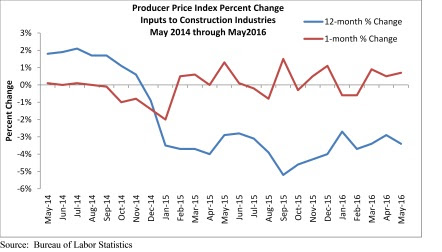Construction input prices expanded by 0.7% in May and have now expanded for three consecutive months according to an analysis of the Bureau of Labor Statistics Producer Price Index released by Associated Builders and Contractors (ABC). The rise follows eight consecutive months during which construction input prices fell; prices remain 3.4% below their year-ago level.
Nonresidential construction input prices expanded by 0.9% in May, but are still 3.5% below their year-ago level. Price gains were largely driven by iron and steel prices and steel mill product prices, which expanded 5.8% and 4.6% for the month, respectively.
"After falling sharply during all of 2015 and into the early months of 2016, an increase in global commodities prices had to happen as markets firmed," said ABC Chief Economist Anirban Basu. "While much attention has been given to the recent rise in oil prices to around $50 per barrel, other commodity prices have also experienced a resurgence, including iron ore.
"That said, the global economy continues to disappoint relative to expectations established at the start of the year," said Basu. "Higher prices may stimulate new rounds of production, including in energy markets, but the implication is that prices are unlikely to rise smoothly or dramatically going forward. Analyst views regarding the direction of commodity prices diverge wildly. While supply and demand play a role in fashioning commodity prices, so too does the value of the U.S. dollar. U.S. interest rates remain low and in many cases have been declining. The dollar has correspondingly weakened in recent weeks. Should that continue, commodity price increases could be sharper than we presently anticipate."

Nine key input prices expanded or remained unchanged in May on a monthly basis:
- Crude petroleum prices expanded 0.6% from April 2016, but are down 32.5% from May 2015.
- Unprocessed energy material prices expanded 0.9% on a monthly basis, but have fallen 23.1% on a year-ago basis.
- Prices for steel mill products expanded 4.6% from a month ago, but are down 5.2% on a yearly basis.
- Iron and steel prices expanded 5.8% month-over-month, but are down 2% year-over-year.
- Softwood lumber prices expanded 2.2% for the month and 6.3% from May 2016.
- Fabricated structural metal prices remained unchanged month-over-month and are down 1.9% year-over-year.
- Prices for plumbing fixtures and fittings expanded 0.2% for the month and are up 0.3% from the same time last year.
- Prices for prepared asphalt and tar and roofing and siding products expanded by 0.4% month-to-month and 0.7% year-over-year.
- Natural gas prices rose 2.9% for the month, but are down 23.5% from the same period one year ago.
Two key input prices declined on a monthly basis:
- Nonferrous wire and cable prices fell 1.3% on a monthly basis and have fallen 9.2% on a yearly basis.
- Concrete product prices inched down by 0.1% month-over-month, but are up 3% year-over-year.
Related Stories
| Oct 25, 2011
Commitment to green building practices pays off
The study, conducted by the Pacific Northwest National Laboratory, built on a good indication of the potential for increased productivity and performance pilot research completed two years ago, with similarly impressive results.
| Oct 20, 2011
Process leads to new design values for southern pine and other visually graded dimension lumber
A summary of the process used to develop new design values will clarify many of the questions received by the SFPA.
| Oct 19, 2011
System for installing grease duct enclosures achieves UL listing
Updated installation results in 33% space savings.
| Oct 18, 2011
Michel Bruneau wins 2012 AISC T.R. Higgins Award
The AISC T.R. Higgins Lectureship Award is presented annually by the American Institute of Steel Construction (AISC) and recognizes an outstanding lecturer and author whose technical paper(s) are considered an outstanding contribution to the engineering literature on fabricated structural steel.
| Oct 18, 2011
Dow Building Solutions invests in two research facilities to deliver data to building and construction industry
State-of-the-art monitoring system allows researchers to collect, analyze and process the performance of wall systems.
| Oct 18, 2011
St. Martin’s Episcopal School expands facilities
Evergreen commences construction on environmentally sustainable campus expansion.
| Oct 17, 2011
Big D Floor covering supplies to offer Johnsonite Products??
Strategic partnership expands offering to south and west coast customers.
| Oct 14, 2011
AISC develops new interoperability strategy to move construction industry forward
AISC is working to bring that vision to reality by developing a three-step interoperability strategy to evaluate data exchanges and integrate structural steel information into buildingSMART's Industry Foundation Classes.
| Oct 14, 2011
University of New Mexico Science & Math Learning Center attains LEED for Schools Gold
Van H. Gilbert architects enhances sustainability credentials.
| Oct 14, 2011
AIA Continuing Education: optimizing moisture protection and air barrier systems
Earn 1.0 AIA/CES learning units by studying this article and passing the online exam.

















